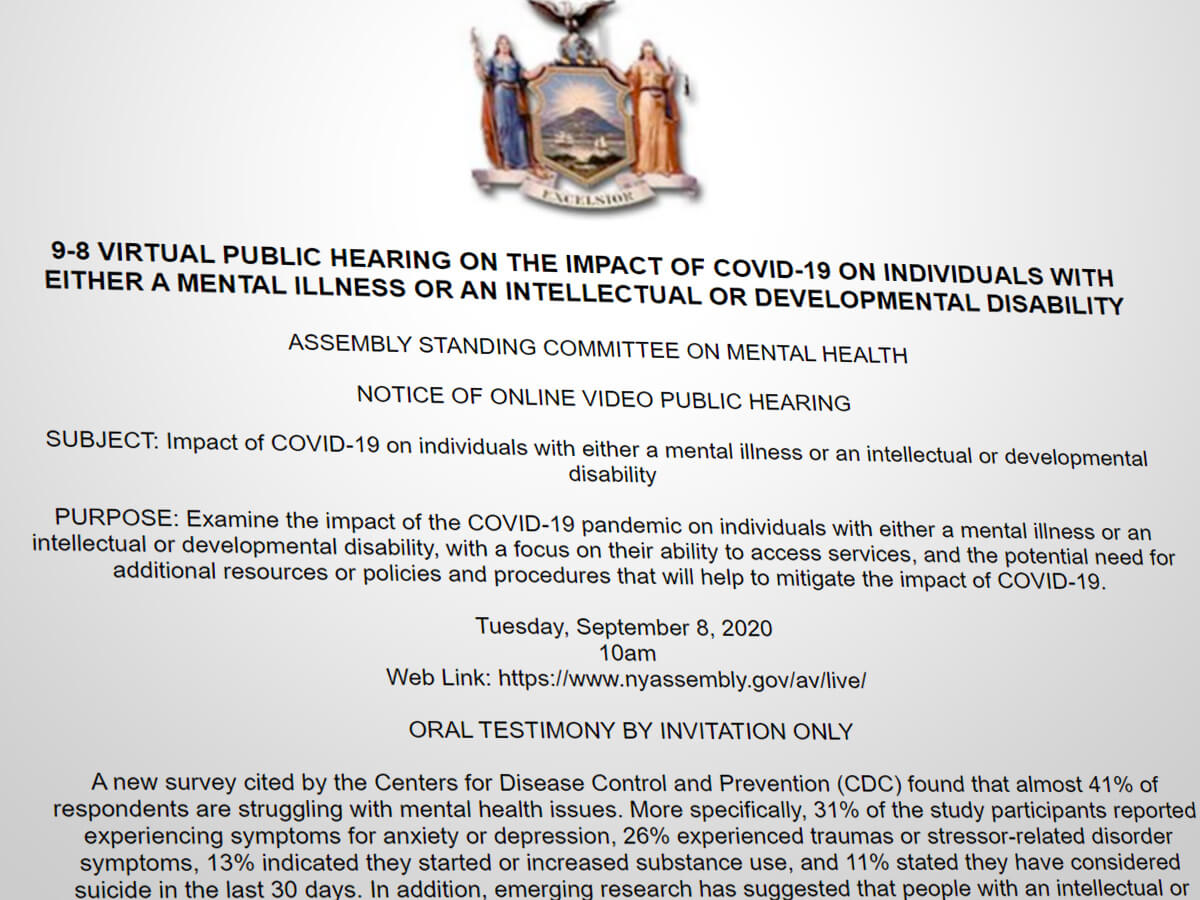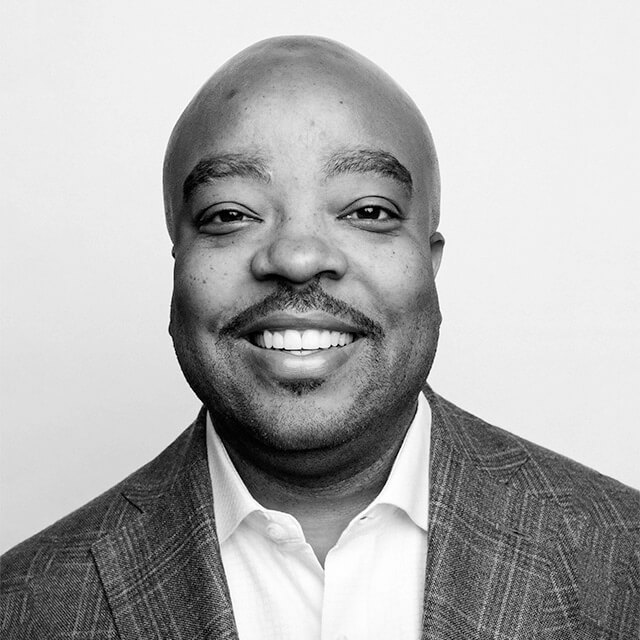WRITTEN TESTIMONY BY
DR. MICHAEL A. LINDSEY, EXECUTIVE DIRECTOR
THE McSILVER INSTITUTE FOR POVERTY POLICY AND RESEARCH
AT NEW YORK UNIVERSITY
IMPACT OF COVID-19 ON INDIVIDUALS WITH MENTAL ILLNESS OR INTELLECTUAL OR DEVELOPMENTAL DISABILITY
BEFORE THE ASSEMBLY STANDING COMMITTEE ON MENTAL HEALTH
NEW YORK STATE
September 8, 2020
Esteemed Assembly Members, I greet you as the Executive Director of the NYU McSilver Institute for Poverty Policy and Research, and the Constance and Martin Silver Professor of Poverty Studies at the NYU Silver School of Social Work. At the McSilver Institute, we are committed to creating new knowledge about the root causes of poverty, developing evidence-based interventions to address its consequences, and rapidly translating research findings into action through policy and practice.
As we are well aware, the COVID-19 pandemic has disrupted millions of lives, infected at least 6 million nationwide, and taken more than 180,000 lives within our borders.[1] More than 32,000 people are currently hospitalized. These statistics put the viral illness as the third primary cause of death in the United States in 2020, lagging behind only heart disease and cancer.
Meanwhile, the impacts of the pandemic on our youth—both physical and mental—has been overlooked. As schools start to reopen for the academic year, more children are reportedly developing COVID-19. The New York Times reports that since the end of May, COVID-19 diagnoses are up 720 percent in children in the United States compared to 270 percent for all Americans.[2] Deaths are up over 350 percent for children compared to 122 percent for all Americans.
The impact of COVID-19 on the education and mental health of youth has been extraordinary in a number of ways. Brookings Institution data suggest that students (grades 3-8) could begin fall 2020 with approximately 70% of the learning gains in reading from the year before, relative to a typical school year.[3] In mathematics, students may demonstrate even lower learning gains from the previous year, coming back less than 50% of the gains. In lower grades, students may be nearly a full year behind in math in comparison to what we would observe under normal conditions.
Children in communities of color are especially vulnerable to falling behind. Around 50 percent of Black and Latino adults and 40 percent of white adults in households with school-enrolled children who contributed to a Household Pulse Survey said that at least one child had their class cancelled because of COVID-19. Many households, particularly families of color, face significant challenges to facilitating a learning environment that is comparable to in-person instruction.
Virtual learning presents challenges. Although most low- and moderate-income families have some form of Internet connection, many families are under-connected, with mobile-only access and inconsistent connectivity. Before COVID-19, a 2015 Pew Survey found that 45% of teens who live in households earning less than $30,000 a year said they at least sometimes relied on their cellphone to finish their homework.[4] In the pandemic of 2020, I cannot imagine what that percentage would be—certainly much, much higher.
The COVID-19 pandemic may also worsen existing mental health problems and lead to more cases among children and adolescents, due to the unique combination of the public health crisis, social isolation, and economic recession. Schools are “the de facto mental health system for many children and adolescents,” delivering mental health services to 57 percent of adolescents who require care, according to the authors of a recent study published in JAMA Pediatrics.[5] Among adolescents who received any mental health services during 2012 to 2015, 35% received their mental health services entirely from school settings. School closures will be particularly troublesome for the mental health services of that group; and indeed, for children from lower-income families.
Youth of color have long faced barriers to mental health care in areas of prevention, access to care, quality treatment and mental health outcomes. The onset of COVID-19 has only augmented that burden on them. Access to care has become even more trying due to previous closings of clinics and hospitals and social distancing rules and guidelines.
Those most severely impacted face the greatest barriers to care. Long-standing systemic health and social inequities have put the Black community at an increased risk of getting COVID-19 or experiencing severe illness, according to the Centers for Disease Control and Prevention.[6] The disproportionate deaths and illnesses can be additional stressors for a teen who is already experiencing stress, anxiety or depression. School closures and sheltering at home in the COVID-19 pandemic isolate children and adolescents from peers, teachers, extended family, and community. In a survey performed during the pandemic, one-third of adolescents stated elevated levels of loneliness.[7]
In light of these statistics, and as a mental health scholar, practitioner, and advocate, I am concerned that not enough attention is being paid to the education and mental health outcomes for youth of color. Prior to the COVID-19 pandemic, 4,810 Black children below age 17 in New York City received services from the state’s public mental health system in 2017, according to the New York State Office of Mental Health.[8] This figure is up 4 percent since 2015, with the caveat that it is likely to be even higher in relation to the 2020 pandemic.
Who knows how many needs are being unmet among our state’s youth of color, particularly after the disruptions to life and economic well-being caused by the COVID-19 pandemic? We do know that young people who have access to school-based mental health services are 21 times more likely to seek care for mental health reasons than to seek mental health services in the community, according to a 2003 study by researchers at the School Health Program of Montefiore Medical Center.[9] Yet, there aren’t nearly enough professionals with mental health training in the city’s public schools. As Manhattan Borough President Gale Brewer reported in 2017, the New York City Department of Education employed 1,183 social workers in New York City public schools, or approximately one for every 900 students. That is not enough. We need more social workers proportionate to the school population, and they must be trained to deliver services in the current learning environment.
In closing, we at the McSilver Institute recommend that New York State prioritize the mental health and related educational outcomes for Black and Brown youth, ensuring that these youth are not further traumatized as a result of the pandemic as their mental health needs are left unmet—mental health needs that oftentimes encumber their ability to learn and succeed, academically.
Thank you.
Sincerely,
Michael A. Lindsey, PhD, MSW, MPH
[1] https://gisanddata.maps.arcgis.com/apps/opsdashboard/index.html#/
bda7594740fd40299423467b48e9ecf6
[2] https://www.nytimes.com/interactive/2020/08/31/us/coronavirus-cases-children.html
[5] https://jamanetwork.com/journals/jamapediatrics/fullarticle/2764730
[6] https://www.cdc.gov/coronavirus/2019-ncov/community/health-equity/race-ethnicity.html
[7] https://www.jwatch.org/na51821/2020/06/18/loneliness-and-mental-health-young-people-possible-effects
[8] Citizen’s Committee for Children of New York. Children Receiving Mental Health Services. Race/Ethnicity: Black; City; Number; 2017. Retrieved from https://data.cccnewyork.org/data/map/173/children-receiving-mental-health-services#174/12/1/300/25/a/a
[9] Juszczak L, Melinkovich P, Kaplan D. (2003) Use of Health and Mental Health Services by Adolescents Across Multiple Delivery Sites. The Journal of Adolescent Health. 32(6 Suppl):108-18.

